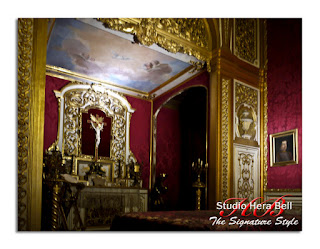We were headed off to Pitti Palace for the day.
The wealthy Pitti family started to build their palace on the South side of the Arno river in 1458. While the Medici's were the dominant family, other powerful families joslted for position. Financial meltdowns are not a new phenomenum of our day. The Pitti family went bankrupted, and never finished their palace. A couple of years after Lorenzo the Magnificent's death, so did the Medici banks fail, leading to the exile of the Medici's.
In Rome, the Medici's re-established their power base. The Medici's definitely had friends in high places, and a struggle to re-establish the family in Florence ensued, backed by the Church and neighboring powers. Lorenzo the Magnificent's son soon became Pope Leo X, and ten years later Lorenzo's nephew became Pope Clement VII. Women too played their role, as Catherine de' Medici would marry the future King Henry II of France.
Back in Florence, rich, powerful, and backed by immensely powerful friends in the Church and neighboring states, the Medici's were once again the top family. Weilding enormouse power and influencing the world, the family remained dominant, but they would never regain the near omnipotence that the Medici's once had. The center of the world was shifting to Paris.
Almost a century after the Pitti's started to build their palace, the Medici's bought it in 1549, expanding it, and then moving the family residence there.
Surprised, we learned that the Palace was opened for free this day. I tried to pick up an audioguide, but alas, the ones that had been returned were all charging and would not be ready for another hour. So we toured the palace on our own.
The art collection here is enormous. Walls are covered in paintings three or more rows high. While not displayed to fully give justice to the pieces of work, I much preferred my tour of the Pitti Palace's collection than the Uffizi's collection.
The palace also displays several of the sumptious rooms, filled with furnishings of the day. Many rooms, were redecorated and updated to the tastes of the day, and reminded me of the royal apartments of France. (I did say earlier that the centre of the world had moved from Florence to Paris.)
In addition, there is a museum of fashion, that Hera particularly enjoyed. I enjoyed it as well, and I particularly liked the way the curator placed similar styles of clothing of different epochs next to each other.
As we were about to leave, and visit the Boboli gardens, the sky opened up, and the rain poured down. We meandered about the palace for awhile, and like most summer rains, it was soon over.
A few times I had commented to Hera, that Florence lacks parks and green spaces. While very manicured, the Boboli gardens were a welcomed relief. Free today, there is normally an admission charge to walk the gardens. With so little green space, I hope the City of Florence one day decides to let the Boboli Gardens be open and free for all to enjoy.
Hera was ecstatic. Held back from taking photos in the museum (again I hope Florence will soon allow photographing in museums), and with scenic vistas and details gallore, Hera found images everywhere to photograph. Wide lanes lined with sculptures, lovely enchanting little pathways, fountains and views, one can spend hours if not days strolling the park.
Meandering the streets of the Oltrarno, we headed towards Ponte Vecchio. I knew Hera loved the little cannolos we had a couple of times already, so I reminded her, and she was thrilled to re-visit her favorite pastry shop. We had tried pastries elsewhere, but thus far, this is our favorite. (Caffe Royal - Ristorante de' Bardi sr1 Via de' Bardi 54-64 R)
We hurried back to our apartment. Time had flown by, and though our day was over, we were both excited and eager for the evening ahead.
Cheers,
Hera & Anthony























































